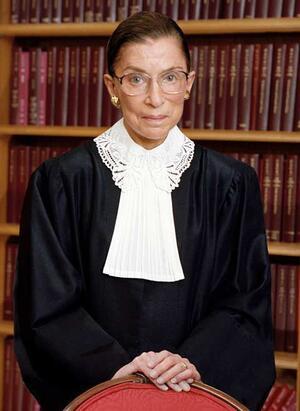Ruth Bader Ginsburg joins U.S. Supreme Court
On June 14, 1993, President Bill Clinton nominated Ruth Bader Ginsburg to be an associate justice on the United States Supreme Court. When she was sworn in, on August 10, 1993, she became the second woman, and the first Jewish woman, to serve on the Supreme Court. Ginsburg replaced retiring justice Byron R. White.
Born in Brooklyn on March 15, 1933, Ginsburg was the first in her immediate family to attend college. She earned her B.A. from Cornell, with High Honors in Government, in 1954. Admitted to Harvard Law School, she delayed her studies to move with her husband to Oklahoma, where she worked for the Social Security Administration. Returning east, Ginsburg enrolled at Harvard in 1956, but switched to Columbia Law School for her final year when her husband accepted a job offer from a prestigious New York law firm. At both Harvard and Columbia, Ginsburg was accepted to the Law Review; at Columbia, she tied for first in her class.
Despite this record of achievement, Ginsburg found it difficult to work as a lawyer upon graduation. Few judges and no law firms were willing to accept a woman as clerk or staff member. Finally, she won a clerkship with Judge Edmund L. Palmieri of the U.S. District Court for the Southern District of New York. Palmieri accepted her only on the promise from a male lawyer that if Ginsburg did not work out, he would find an overqualified man to take her place. That proved unnecessary. After her clerkship, Ginsburg worked for the Columbia Project on International Civil Procedure, which did basic research on foreign systems of civil procedure and recommended changes in the U.S. system of transnational litigation.
With the completion of the Columbia Project, Ginsburg embarked on an academic career, first at Rutgers University (1963-1972) (where she was paid less than her male colleagues), and then at Columbia (1972-1980), where she was the first tenured woman on the law faculty. Just before her move to Columbia, Ginsburg also became co-director of the ACLU's Women's Rights Project.
Dividing her time between Columbia and the ACLU, Ginsburg worked extensively on sex-discrimination cases, especially those relating to employment. In this work, Ginsburg filed briefs in nine major sex discrimination cases that were decided by the Supreme Court, personally arguing six of them. Ginsburg argued that protections granted to persons under the constitution should apply to women and, thus, successfully established that differential treatment based on gender was unconstitutional.
In 1980, President Jimmy Carter appointed Ginsburg to the U.S. Court of Appeals for the District of Columbia. She served there for thirteen years, until her nomination and confirmation to the U.S. Supreme Court. In nominating Ginsburg to the Supreme Court, President Clinton described her as "one of our nation's best judges, progressive in outlook, wise in judgment, balanced and fair in her opinions." He also said that "Ruth Bader Ginsburg cannot be called a liberal or a conservative. She has proved herself too thoughtful for such labels." Ginsburg's record as a centrist likely helped to ease her confirmation; the Senate Judiciary Committee unanimously endorsed her nomination, and the full Senate voted 96-3 in her favor.
On the Court, Ginsburg's work was characterized by cool logic and reason, and a pragmatism that took into account the real-life implications of Court decisions. In her written decisions she continued to establish the constitutional basis for prohibiting discrimination based on gender. During the 2006–2007 session of the Court, Justice Ginsburg took the unusual step of reading two of her dissents orally. Observers saw these forceful and passionate dissents as evidence of Ginsburg's growing frustration with the decisions and reasoning of her more conservative colleagues.
Justice Ginsburg took an active role in the 2004-2005 celebration of the 350th anniversary of Jewish life in North America, pointing proudly to Judaism's eternal pursuit of justice, the promise of America, and the accomplishments of Jewish women who have preceded her. The resignation of Justice Sandra Day O'Connor in 2005 left Justice Ginsburg as the only woman on the Supreme Court until the confirmation of Justice Sonia Sotomayor in August of 2009. On August 5, 2010, Elena Kagan was confirmed to the Supreme Court. She joined Justices Ginsburg and Sotomayor as the third woman on the bench, and was the second Jewish woman to become a Supreme Court Justice.
Ruth Bader Ginsburg died on September 18, 2020.
Sources:
Jewish Women in America: An Historical Encyclopedia, pp. 515-520.
Symposium: Celebration of the Tenth Anniversary of Justice Ruth Bader Ginsburg's Appointment to the Supreme Court of the United States (New York, 2004).
New York Times, June 15, 1993, August 4, 1993, May 26, 1999, May 31, 2007.



